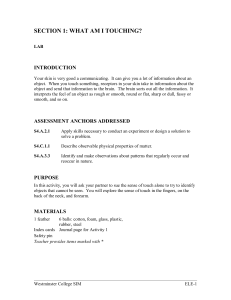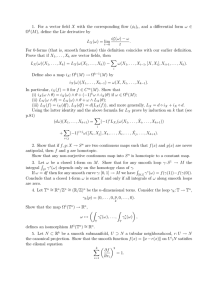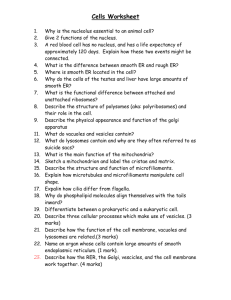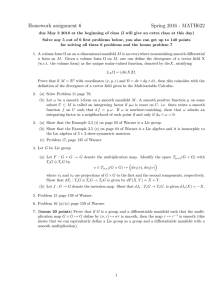Math 147, Homework 1 Solutions Due: April 10, 2012
advertisement
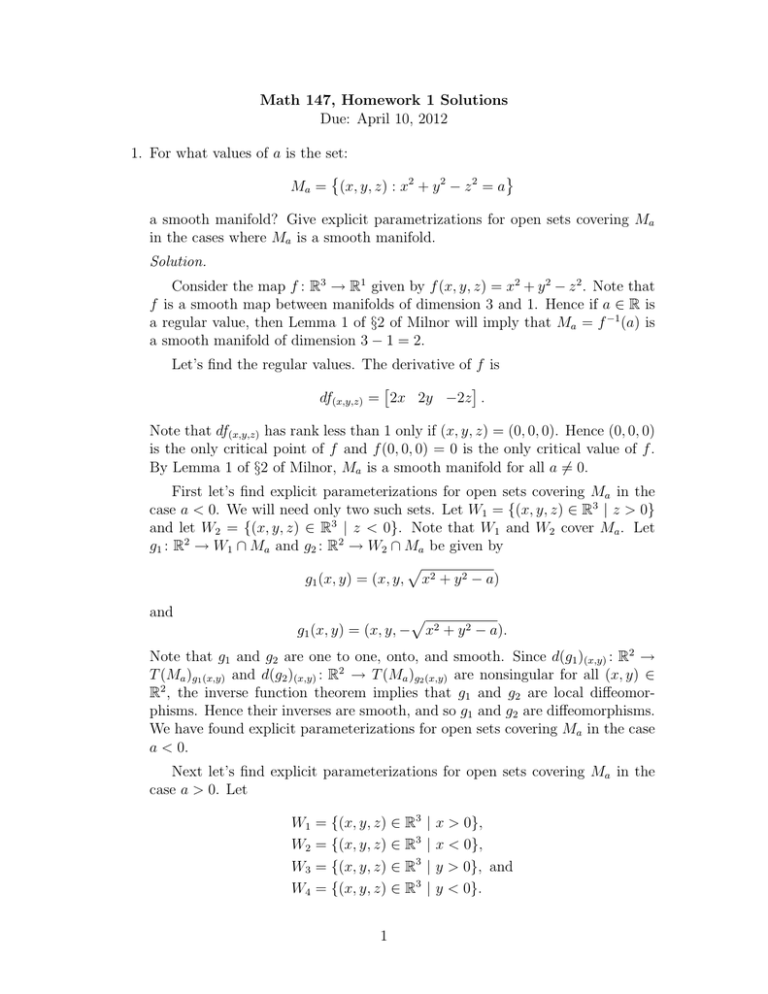
Math 147, Homework 1 Solutions
Due: April 10, 2012
1. For what values of a is the set:
Ma = (x, y, z) : x2 + y 2 − z 2 = a
a smooth manifold? Give explicit parametrizations for open sets covering Ma
in the cases where Ma is a smooth manifold.
Solution.
Consider the map f : R3 → R1 given by f (x, y, z) = x2 + y 2 − z 2 . Note that
f is a smooth map between manifolds of dimension 3 and 1. Hence if a ∈ R is
a regular value, then Lemma 1 of §2 of Milnor will imply that Ma = f −1 (a) is
a smooth manifold of dimension 3 − 1 = 2.
Let’s find the regular values. The derivative of f is
df(x,y,z) = 2x 2y −2z .
Note that df(x,y,z) has rank less than 1 only if (x, y, z) = (0, 0, 0). Hence (0, 0, 0)
is the only critical point of f and f (0, 0, 0) = 0 is the only critical value of f .
By Lemma 1 of §2 of Milnor, Ma is a smooth manifold for all a 6= 0.
First let’s find explicit parameterizations for open sets covering Ma in the
case a < 0. We will need only two such sets. Let W1 = {(x, y, z) ∈ R3 | z > 0}
and let W2 = {(x, y, z) ∈ R3 | z < 0}. Note that W1 and W2 cover Ma . Let
g1 : R2 → W1 ∩ Ma and g2 : R2 → W2 ∩ Ma be given by
p
g1 (x, y) = (x, y, x2 + y 2 − a)
and
p
g1 (x, y) = (x, y, − x2 + y 2 − a).
Note that g1 and g2 are one to one, onto, and smooth. Since d(g1 )(x,y) : R2 →
T (Ma )g1 (x,y) and d(g2 )(x,y) : R2 → T (Ma )g2 (x,y) are nonsingular for all (x, y) ∈
R2 , the inverse function theorem implies that g1 and g2 are local diffeomorphisms. Hence their inverses are smooth, and so g1 and g2 are diffeomorphisms.
We have found explicit parameterizations for open sets covering Ma in the case
a < 0.
Next let’s find explicit parameterizations for open sets covering Ma in the
case a > 0. Let
W1
W2
W3
W4
= {(x, y, z) ∈ R3
= {(x, y, z) ∈ R3
= {(x, y, z) ∈ R3
= {(x, y, z) ∈ R3
1
|
|
|
|
x > 0},
x < 0},
y > 0}, and
y < 0}.
Note that these sets cover Ma . Let
g1 :
g2 :
g3 :
g4 :
{(y, z) ∈ R2
{(y, z) ∈ R2
{(x, z) ∈ R2
{(x, z) ∈ R2
| a − y 2 + z 2 > 0} → W1 ∩ Ma ,
| a − y 2 + z 2 > 0} → W2 ∩ Ma ,
| a − x2 + z 2 > 0} → W3 ∩ Ma , and
| a − x2 + z 2 > 0} → W4 ∩ Ma
be given by
p
a − y 2 + z 2 , y, z),
p
g2 (y, z) = (− a − y 2 + z 2 , y, z),
√
g3 (x, z) = (x, a − x2 + z 2 , z), and
√
g4 (x, z) = (x, − a − x2 + z 2 , z).
g1 (y, z) = (
Note that g1 , g2 , g3 , and g4 are one to one, onto, and smooth. Since the derivatives of g1 , g2 , g3 , and g4 are nonsingular at each point in their domains, the inverse function theorem implies that g1 , g2 , g3 , and g4 are local diffeomorphsims.
Hence their inverses are smooth, and g1 , g2 , g3 , and g4 are diffeomorphisms.
We have found explicit parameterizations for open sets covering Ma in the case
a > 0.
Conversely, set M0 is not a manifold. Set M0 is a cone, as drawn in Figure 12 in Guillemin and Pollack. We will show that there is no neighborhood W ∩M0
about the point (0, 0, 0) ∈ M0 diffeomorphic to an open subset U of R2 .
Suppose for a contradiction that there is a diffeomorphism g : U → W ∩ M0 ,
where U is an open subset of R2 and where W ∩M0 is a neighborhood about the
point (0, 0, 0) ∈ M0 . By restricting this diffeomorphism to a single connected
component, we can assume that both W and U are connected. Let u ∈ U be
the point satisfying g(u) = (0, 0, 0). Note that g restricts to a diffeomorphism
from U \ {u} to (W ∩ M0 ) \ {(0, 0, 0)}. However U \ {u} is a connected set
while (W ∩ M0 ) \ {(0, 0, 0)} is not. A connected set cannot be homeomorphic to
a disconnected set, so this is a contradiction. Hence there is no neighborhood
W ∩ M0 about the point (0, 0, 0) ∈ M0 diffeomorphic to an open subset U of
R2 . So M0 is not a manifold.
2. (a) Show that the interval (a, b) is diffeomorphic to (0, 1) whenever b > a.
Solution.
Define f : (a, b) → (0, 1) by f (x) = (x − a)/(b − a) for a < x < b. Note
that f is one to one, onto, and smooth since its a polynomial. The inverse
map f −1 (y) = (b − a)y + a is also smooth since its a polynomial. Hence f is a
diffeomorphism, so (a, b) and (0, 1) are diffeomorphic.
(b) Show that R1 is diffeomorphic to (0, 1).
Solution.
2
By part (a), (0, 1) is diffeomorphic to (−π/2, π/2). Hence we need only
show that R1 is diffeomorphic to (−π/2, π/2), since diffeomorphisms form an
equivalence relation.
Consider tan : (−π/2, π/2) → R1 which is one to one and onto. Note tangent
is smooth on (−π/2, π/2), which one can see since its derivative is 1/ cos2 and
cosine is smooth and positive on this range. The inverse function theorem then
implies that tangent is a local diffeomorphism on this range, and hence its
inverse is also smooth. So R1 is diffeomorphic to (−π/2, π/2) and also to (0, 1).
(c) Is the function f (x) = x3 a diffeomorphism from R1 → R1 ?
Solution.
No. The inverse function f −1 =
(1/3)x−2/3 is not defined at 0.
√
3
x is not smooth, since its derivative
3. Let M ⊂ Rk and N ⊂ Rl be manifolds of dimensions m and n respectively.
(a) Show that the Cartesian product M × N consisting of pairs (x, y) ∈ Rl × Rk
with x ∈ M and y ∈ N is a smooth manifold of dimension m + n.
Solution.
Let (x, y) ∈ M × N . Since M is a smooth manifold, there exists a neighborhood WM containing x in Rm and a diffeomorphism gM : UM → WM ∩ M
where UM is an open subset of Rm . Since N is a smooth manifold, there exists a
neighborhood WN containing y in Rn and a diffeomorphism gN : UN → WN ∩ N
where UN is an open subset of Rn .
Note that UM × UN is an open subset of Rm+n , that WM × WN is an open
subset of Rk+l , and that
gM × gN : UM × UN → (WM ∩ M ) × (WN ∩ N ) = (WN × WN ) ∩ (M × N )
defined by (gM × gN )(u, u0 ) = (gM (u), gN (u)) is a diffeomorphism. Since our
point (x, y) ∈ M ×N was arbitrary, this shows that M ×N is a smooth manifold
of dimension m + n.
(b) If x ∈ M and y ∈ N , show that the tangent space T (M × N )(x,y) is the
Cartesian product T Mx × T Ny .
Solution.
Let (u, u0 ) ∈ UM × UN satisfy (gM × gN )(u, u0 ) = (x, y). The tangent space
T (M × N )(x,y) is defined to be the image d(gM × gN )(u,u0 ) (Rm+n ). Recall d(gM ×
gN )(u,u0 ) and d(gM )u × d(gN )u0 are each (k + l) × (m + n) matrices of partial
derivatives. These matrices both have d(gM )u in the top left block, d(gN )u0 in
the bottom right block, and zeros in all other entries. Hence we have
d(gM × gN )(u,u0 ) = d(gM )u × d(gN )u0 .
3
So
T (M × N )(x,y) = d(gM × gN )(u,u0 ) (Rm+n )
= d(gM )u × d(gN )u0 (Rm+n )
= d(gM )u (Rm ) × d(gN )u0 (Rn )
= T Mx × T Ny .
(c) Let f : M → M 0 and g : N → N 0 be smooth maps between manifolds and
f × g : M × N → M 0 × N 0 be the product map defined by (f × g)(x, y) =
(f (x), g(y)). Show that the derivatives of f , g and f × g satisfy:
d(f × g)(x,y) = dfx × dgy .
Solution.
0
0
Let M 0 ⊂ Rk and N 0 ⊂ Rl . Since f : M → M 0 is smooth there exists
0
an open set WM containing x in Rk and a smooth map F : WM → Rk that
coincides with f on WM ∩ M . Since f : N → N 0 is smooth there exists an open
0
set WN containing y in Rl and a smooth map G : WN → Rl that coincides with
0
0
g on WN ∩ N . Now F × G : WM × WN → Rk +l is a smooth map that coincides
with f × g on
(WM ∩ M ) × (WN ∩ N ) = (WM × WN ) ∩ (M × N ).
Since F and G have domains that are open subsets of Euclidean space, an
argument identical to that in part (b) shows that
d(F × G)(x,y) = dFx × dGy .
Indeed, these are each (k 0 + l0 ) × (k + l) matrices with d(F )x on the top left
block, d(G)y on the bottom right block, and zeros elsewhere.
Let (v, v 0 ) ∈ T (M × N )(x,y) = T Mx × T Ny . By definition of d(f × g)(x,y) , we
have
d(f × g)(x,y) (v, v 0 ) = d(F × G)(x,y) (v, v 0 )
= (dFx × dGy )(v, v 0 )
= dFx (v) × dGy (v 0 )
= dfx (v) × dgy (v 0 )
= (dfx × dgy )(v, v 0 ).
Since our point (v, v 0 ) was arbitrary, this shows that
d(f × g)(x,y) = dfx × dgy .
4
4. Let X ⊂ R3 be the circle of radius one in the xz-plane centered at (2, 0, 0) and let
Y be the surface of revolution obtained by rotating X around the z-axis. Show
that Y is a smooth manifold of dimension two and admits a diffeomorphism to
the product S 1 × S 1 ⊂ R4 .
Solution.
Let
W = {(x, y, z) | z 6= 1 and either y 6= 0 or x < 0}
and
W 0 = {(x, y, z) | z 6= −1 and either y 6= 0 or x > 0}.
One can check that W and W 0 cover Y .
Let U = {(u, v) ∈ R2 | 0 < u < 2π and π/2 < v < 5π/2}. A diffeomorphism
g : U → W ∩ Y is given by
g(u, v) = (2 + cos v) cos u, (2 + cos v) sin u, sin v .
This map is a homeomorphism and smooth. Because its derivative is everywhere
nonsingular, the inverse function theorem implies that its inverse is also smooth.
Similarly, let U 0 = {(u, v) ∈ R2 | − π < u < π and − π/2 < v < 3π/2}. A
diffeomorphism g 0 : U 0 → W 0 ∩ Y is also given by
g(u, v) = (2 + cos v) cos u, (2 + cos v) sin u, sin v .
This map is a homeomorphism and smooth. Because its derivative is everywhere
nonsingular, the inverse function theorem implies that its inverse is also smooth.
Hence Y is a smooth manifold of dimension two.
Next we show that Y is diffeomorphic to S 1 × S 1 ⊂ R4 . We define f : S 1 ×
S 1 → Y by setting
f (a, b, c, d) = (2 + c)a, (2 + c)b, d
for (a, b, c, d) ∈ S 1 × S 1 . Map f is one to one and onto. Map f is smooth
because it extends to a smooth map, given by the same formula, on all of R4 .
One can check that the inverse f −1 : Y → S 1 × S 1 is given by
!
p
y
x
,p
, x2 + y 2 − 2, z .
f −1 (x, y, z) = p
x2 + y 2
x2 + y 2
Map f −1 is smooth because it extends to a smooth map, given by the same
formula, on R3 \ {(0, 0, 0)}. So Y is diffeomorphic to S 1 × S 1 .
5. Recall that an n × n matrix A is orthogonal if it is invertible and A−1 = AT .
Show that the set SO(2) of 2 × 2 orthogonal matrices of determinant 1 is a
smooth manifold of dimension one diffeomorphic to S 1 . What is the tangent
space to SO(2) at the identity matrix? (Note: in this question, the set of all
5
two-by-two matrices is identified with R4 ; a matrix A corresponds to the vector
whose coordinates are the coefficients of A).
Solution.
We will identify the 2 × 2 matrix
x z
A=
y w
with the point (x, y, z, w) ∈ R4 . If matrix A has determinant 1, then its inverse
is
w −z
−1
A =
.
−y x
If A−1 = AT , then x = w and y = −z. Since the determinant of A is 1, we have
1 = xw − yz = x2 + y 2 .
Hence any matrix in SO(2) can be written as
x −y
A=
= (x, y, −y, x)
y x
with (x, y) ∈ S 1 .
We define f : S 1 → SO(2) by setting
f (x, y) = (x, y, −y, x).
Map f is one to one, and it is onto by our work above. Map f is smooth because
it extends to a smooth map F , given by the same formula, on all of R2 . The
inverse f −1 : SO(2) → S 1 is smooth because it extends to the smooth map
(x, y, z, w) 7→ (x, y)
defined on all of R4 . Hence SO(2) is diffeomorphic to S 1 , and so is also a smooth
manifold of dimension one.
Now let’s find the tangent space to SO(2) at the identity matrix. Note
f (1, 0) = (1, 0, 0, 1) is the identity matrix I. The assertion on page 7 of Milnor
1
says that df(1,0) : T S(1,0)
→ T SO(2)I is an isomorphism of vector spaces. Note
1
1
T S(0,1) = {(0, t) | t ∈ R } and
dF(1,0)
1 0
0 1
=
0 −1
1 0
6
where F is the extension of f to all of R2 . Hence
1
)
T SO(2)I = df(1,0) (T S(1,0)
1
) by definition
= dF(1,0) (T S(1,0)
( 1 0 )
0 1 0
1
=
0 −1 t | t ∈ R
1 0
= (0, t, −t, 0) | t ∈ R1
as vectors in R4
)
(
0 −t
as matrices.
=
| t ∈ R1
t 0
6. The stereographic projection is the map f from S 2 \ {(0, 0, 1)} to the xy-plane
sending (x, y, z) to the unique point in the xy-plane lying on the line through
(0, 0, 1) and (x, y, z).
(a) Show that f is a diffeomorphism onto the xy-plane. In particular, the open
set S 2 \ {(0, 0, 1)} can be parametrized by a single function. [Hint: You should
be able to write down explicit formulas for f and f −1 .]
Solution.
The map f : S 2 \ {(0, 0, 1)} → R2 is given by
x
y f (x, y, z) =
,
1−z 1−z
for any (x, y, z) ∈ S 2 \ {(0, 0, 1)}. Map f is one to one, onto, and is smooth
because it extends to a smooth map, given by the same formula, on the open
set {(x, y, z) ∈ R3 | z < 1} containing S 2 \ {(0, 0, 1)}. One can check the inverse
f −1 is given by
f −1 (u, v) =
2v
−1 + u2 + v 2 2u
,
,
1 + u2 + v 2 1 + u2 + v 2 1 + u2 + v 2
for any (u, v) ∈ R2 . Since f −1 is also smooth, f is a diffeomorphism onto the
xy-plane.
(b) Show that there is no parametrization of the whole sphere by a single open
set in R2 . [Hint: S 2 is compact.]
Solution.
We will do a proof by contradiction. Suppose there is indeed a parameterization of the whole sphere by a single open set in R2 . This amounts to a
diffeomorphism h : S 2 → U for some open set U ∈ R2 . Since S 2 is compact and
since a continuous image of a compact space is compact, this means U = h(S 2 )
is compact. By the Heine-Borel theorem, U is closed. Since R2 is connected,
the only closed and open sets of R2 are the emptyset and all of R2 . But U
7
cannot be the emptyset because the emptyset is not diffeomorphic to S 2 . Also
U cannot be R2 because R2 is not bounded and hence not compact. So we have
reached a contradiction. Therefore, there is no parameterization of the whole
sphere by a single open set in R2 .
8
